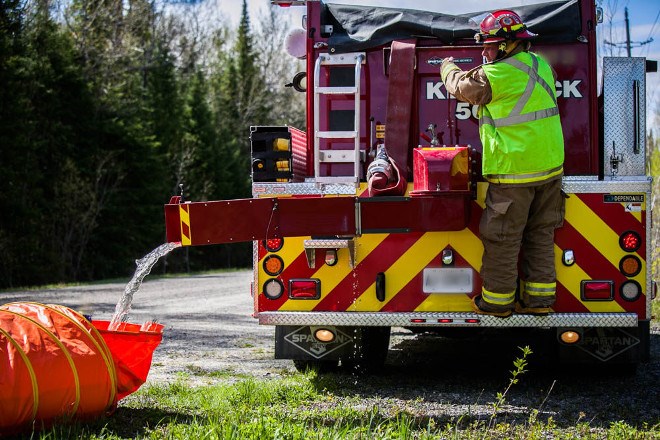In his nearly 30 years as a volunteer firefighter in Timmins, Brian Nankervis has seen his share of tragedy — fatalities that destroy families and burned-out buildings among the most devastating. In each case, the same problem popped up time and again: access to water.
Now, Nankervis has invented a tool that gives firefighters faster, easier access to water while on the job.
The Handy Hydrant is a sturdy but pliable accordion-like tube that holds up to 2,000 gallons of water, depending on the model. It can be transported into awkward spaces that traditional firetrucks may have difficulty traversing and handled with minimal manpower — two issues that continue to plague volunteer fire departments across North America, Nankervis said.
“There used to be five or 10 people standing at the door to be a volunteer firefighter,” he said. “That doesn’t happen anymore.”
When the outcome of a fire can be determined by a matter of seconds, setting up firefighting equipment has to happen quickly and efficiently. The sooner a crew can start putting out a fire, the better the result.
It was this niggling thought that kept Nankervis brainstorming, until one day it hit him: a dog agility tunnel could provide the answer. He purchased his own dog tunnel, made a few modifications, and filled it with a garden hose in his driveway to try and prove his theory.
“It wasn’t perfect, but the concept was there,” Nankervis said.
Four years later, his product has received the backing of an investor through the Northern Ontario Angels program, and his product is ready to hit the market.
It comes in four sizes — 500, 1,000, 1,500 and 2,000 gallons — and can be easily hooked up to a pump and hose that then sprays out the water.
It’s designed primarily for rural and remote areas that don’t have municipal water hookup and source their water from lakes or streams. Rural neighbourhoods, First Nations, and cottage associations are among the communities Nankervis believes can benefit from his invention.
But its portability is also ideal for bush firefighters. Handy Hydrant weighs between 75 and 90 pounds and can be folded up into a backpack or hoisted onto the bed of a pickup truck.
Nankervis cautions the Handy Hydrant isn’t fully replacing the equipment that’s already out there, but can work in tandem with the pumper trucks and tanker trucks that take water from nearby lakes and streams before transferring it to the Handy Hydrant.
“It’s just another tool that we can adapt to what we’re using now,” Nankervis said. “But in most instances, this is probably a better way when you talk about manpower, and time, and setup, and the real estate.”
There are also commercial applications. In industries like construction, agriculture and mining, where water and its associated machinery are pricey commodities, the Handy Hydrant can be a welcome, less expensive alternative.
To start out, Nankervis is targetting rural areas throughout Ontario. With 460-plus volunteer fire stations in Ontario and more than 1,000 First Nations just in the James Bay basin, it provides a good starting market. After that, he plans to promote the Handy Hydrant across the country.
He’s already made contact with some distributors, and has been awarded a distributorship by the manufacturer of a pump that he will sell in conjunction with the Handy Hydrant.
“The ultimate goal is to have one of these tanks on every firetruck, which is a reasonable statement, because that’s what they’re doing now in mostly volunteer, smaller communities,” Nankervis said. “They have a water tank on every truck, if not two.”
He’s also applied for his international patent and next plans to roll out his product across the globe. Nankervis said Handy Hydrant may even find a use watering down winter roads connecting the rest of Ontario to Northern Indigenous communities.
As buzz intensifies about the Handy Hydrant’s benefits, Nankervis remains humble about his budding success.
He plans to maintain his local suppliers and keep the manufacturing in the North — a response to the support and help he’s received from people across Northern Ontario.
Most of all, he wants his product to help people
“Six, seven years ago, I remember a poor, pregnant mother with three kids running around, and it was a windy, hot, humid day, and her house was going up,” he said. “My God, when you’re there beside them, you really feel for them, and you bust your guts to help them out.”




